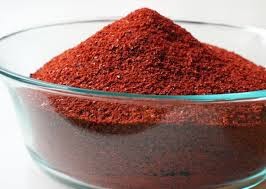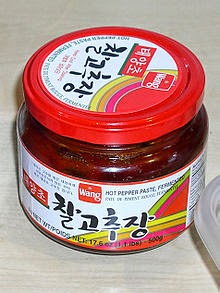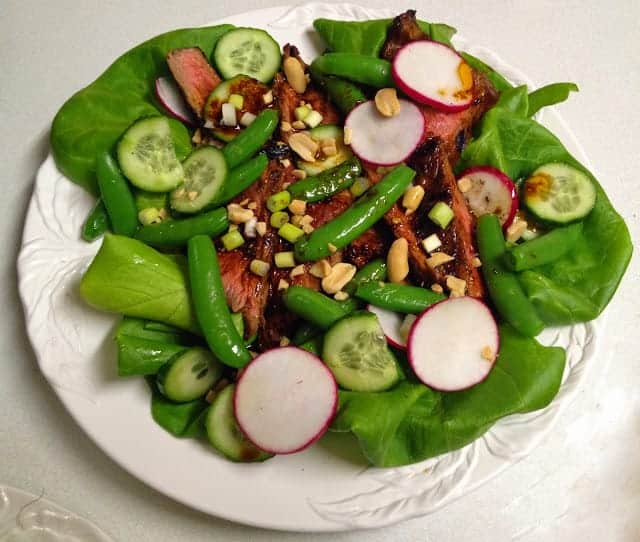 |
| Claire Saffitz |
The bones of this great recipe are from a Bon Appetit writer named Claire Saffitz. Ms Saffitz has an intriguing background. She is a graduate of both Harvard and McGill Universities. At both places she studied History but by the time she got to McGill, she focused on European food history and gastronomy. She also took time between McGill and Harvard (the McGill of The South as any good Montrealer knows) to study at Ecole Gregoire Ferandi in Paris where she obtained a Certificate in Classic French Cuisine. And she certainly knows her way around the kitchen as this recipe proves. Here you have a man’s meal that anyone can feel pious about eating because it’s as much about Spring vegetables as it is about the steak. It’s beautiful to look at and I can’t help but think that it would make a spectacular outdoor lunch the first chance you get. But before you proceed, I have a confession to make: this isn’t the original recipe.
 |
| Gochugaru |
Ms. Saffitz’ original recipe called for several Korean ingredients. Oddly enough, I have the required ingredients…in my other kitchen. Gochujang Hot Pepper Paste is hardly something I could run right out and get. And there’s Gochugaru, which is Korean Red Pepper powder. Frankly, I wasn’t prepared to make a trip down to Koreatown where I could find these two with ease. Gochugaru is one of the backbones of Korean cooking and responsible for its spiciness. To make Gochugaru, Korean red chili peppers are dried in the sun, de-seeded and crushed into flakes. Gochujang, the red pepper
 |
| Gochugang |
paste in the original recipe, consists of Gochugaru added to fermented soy bean paste and rice powder. I wanted to adapt this recipe so that readers with less selection in the Asian food aisle could readily make a version of the dish. Additionally, I was not quite as fussy about the vegetables or the peanuts. Ms. Saffitz called for a mixture of raw and cooked sugar snap peas. And she called for raw peanuts cooked in oil. I blanched all my peas and went with some salted peanuts I had on hand.
 My substitutes for the Korean ingredients are far easier to find. In lieu of Gochujang, I found that Vietnamese Garlic Chili Sauce was a great stand-in and readily available at the supermarket. As to Gochugaru, flying in the face of authenticity, I substituted good old Red Chile Flakes. What I ended up with was a superb marinade that gave the salad an Asian inflection, if not a Korean one. I made this twice: Once with Hanger steak and once with the recommended Flank steak. The Flank steak won out. However I couldn’t help but think that the marinating time made a big difference. I had leftover marinade from version one which allowed me to marinated version two a day in advance. Per the instructions in Ms. Saffitz’s recipe, the taste of the steak gets only gets better if you do. Here is the recipe with both ingredients – the originals and the substitutes.
My substitutes for the Korean ingredients are far easier to find. In lieu of Gochujang, I found that Vietnamese Garlic Chili Sauce was a great stand-in and readily available at the supermarket. As to Gochugaru, flying in the face of authenticity, I substituted good old Red Chile Flakes. What I ended up with was a superb marinade that gave the salad an Asian inflection, if not a Korean one. I made this twice: Once with Hanger steak and once with the recommended Flank steak. The Flank steak won out. However I couldn’t help but think that the marinating time made a big difference. I had leftover marinade from version one which allowed me to marinated version two a day in advance. Per the instructions in Ms. Saffitz’s recipe, the taste of the steak gets only gets better if you do. Here is the recipe with both ingredients – the originals and the substitutes. Sauce
OR 2 tablespoons gochujang (Korean hot pepper paste)
3. Prepare grill for medium-high heat;
lightly oil grates. Remove steak
from marinade and grill, turning twice,
until medium-rare and lightly charred, 8−10 minutes. Transfer to a cutting board and let rest 10 minutes before thinly slicing against the grain.
4. Place peanuts in a resealable plastic bag and seal, pressing out air. Pound with a rolling pin to coarsely crush.













